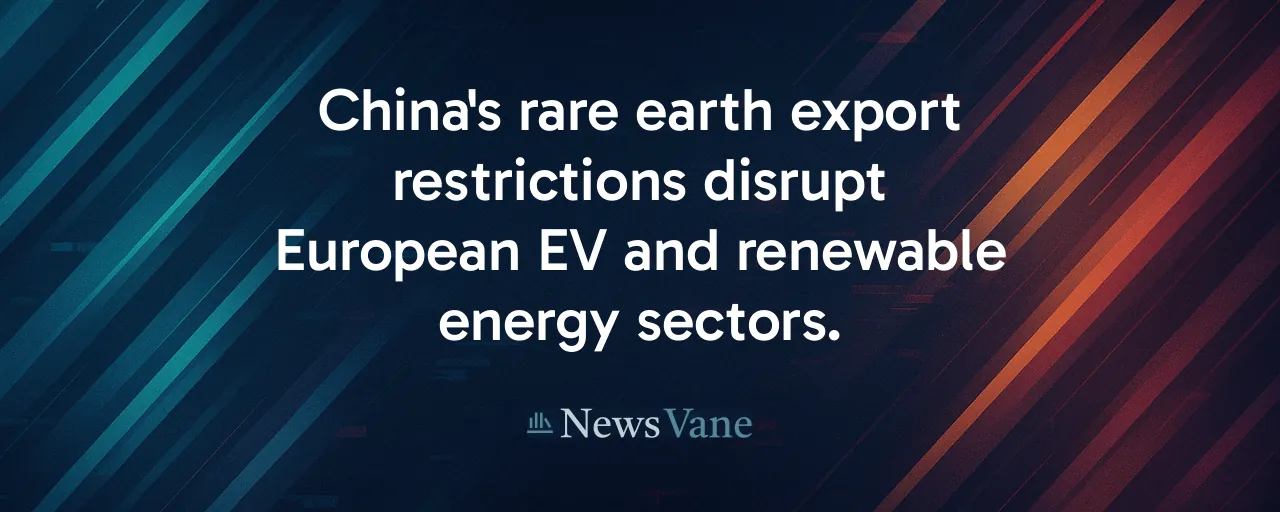A Sudden Squeeze on Critical Minerals
In April 2025, European automakers hit a wall. China, the world's dominant supplier of rare earth elements, tightened export controls on seven critical minerals vital for electric vehicle motors and wind turbines. Factories in Germany, France, and Spain faced shutdowns as license approvals crawled, with only a fraction of applications cleared. The disruption exposed a glaring vulnerability: Europe's reliance on Chinese rare earths threatens its industrial backbone and clean-energy ambitions.
The move by China's Ministry of Commerce sparked alarm across the European Union. These minerals, including dysprosium and terbium, are essential commodities. These include samarium, gadolinium, terbium, dysprosium, lutetium, scandium, and yttrium - elements crucial for magnets in electric vehicles and renewable energy systems. With China refining nearly 90 percent of global supply, its export restrictions sent shockwaves through supply chains, raising questions about economic stability and strategic autonomy.
By June, Beijing responded to mounting pressure, promising a 'green channel' to fast-track approvals for select European and U.S. firms. While some permits now carry six-month validity, the gesture has done little to ease concerns. European officials demand predictable access, viewing temporary fixes as insufficient as they grapple with the complex challenge of securing critical minerals without escalating trade tensions.
Why Rare Earths Matter to Europe
Rare earth elements are the unsung heroes of modern technology. Found in everything from smartphone screens to fighter jets, they are indispensable for Europe's automotive, electronics, and defense sectors. The EU consumes roughly 12 to 15 percent of China's rare earth output, primarily for permanent magnets in electric vehicle motors. A single EV motor can require up to two kilograms of these magnets, making stable supply non-negotiable.
The stakes are high. Prolonged disruptions could shave 0.3 percent off the EU's GDP through losses in automotive production alone. Price spikes, like the 25 percent jump in dysprosium oxide in May 2025, inflate costs for wind turbines and robotics, threatening Europe's green transition. Beyond economics, factory slowdowns endanger tens of thousands of manufacturing jobs, from Stuttgart to Valencia.
China's dominance is no accident. Decades of investment and consolidation have given it a near-monopoly, mining 70 percent and refining 90 percent of global rare earths. Europe has lagged in developing its own supply chains, leaving it exposed to Beijing's strategic maneuvers, as seen in the 2010 export halt to Japan.
A Dual Strategy Takes Shape
Europe is not standing still. The European Commission is pushing a two-pronged approach: immediate diplomacy to stabilize supply and long-term investments to reduce dependence. Talks in Paris and London have yielded results, with China's 'green channel' easing some bottlenecks. Experts warn that diplomacy alone cannot address the structural imbalance. Transparent licensing and strategic stockpiles are critical to manage short-term risks.
The EU is accelerating efforts to diversify supply. Recycling programs could meet up to 20 percent of demand by 2030, according to the International Energy Agency. New mining projects in Europe and allied nations like Australia and Canada are under consideration, though permitting a single mine can take 12 to 16 years. Recycling rare earth magnets also requires building reverse-logistics infrastructure, a costly but necessary step.
Stakeholders are clear on one point: complete decoupling from China is unrealistic before 2030. Demand for rare earths is set to triple by decade's end, driven by electric vehicles and renewable energy. A balanced strategy, blending diplomatic engagement with supply-chain innovation, offers the most practical path forward.
Balancing Trade and Environment
Trade tensions add another layer of complexity. The EU is weighing tariffs on Chinese electric vehicles as a retaliatory measure, but escalation risks derailing climate goals. A trade war could disrupt the rollout of electric vehicles, critical to meeting 2030 emissions targets. Meanwhile, China insists its controls align with global dual-use norms, citing national security and non-proliferation.
Environmental concerns loom large. Opening new mines in Europe or Africa could spark local opposition over ecological damage. In China, rare earth mining has left a legacy of pollution, with workers facing occupational hazards. Any diversification push involves prioritizing low-impact technologies and robust environmental standards to avoid repeating past mistakes.
Compromise is possible. Proposals include an EU-China memorandum to ensure predictable licensing timelines and data transparency. Joint environmental standards for mining and processing could align economic and ecological goals, while coordinated stockpiles among NATO and EU partners could buffer supply shocks.
Lessons From the Past
History offers context for today's crisis. In the 1990s and 2000s, China built its rare earth dominance through quotas and taxes. The 2010 embargo on Japan showed its willingness to flex that power. A 2014 WTO ruling forced China to drop formal quotas, but it pivoted to licensing and environmental inspections. The 2023 ban on transferring extraction technology abroad further tightened its grip.
These events underscore a recurring challenge: reliance on a single supplier creates vulnerability. Europe's current predicament echoes Japan's in 2010, but the scale is larger, with clean-energy goals amplifying the urgency. The lesson is clear: diversification and resilience require prioritization to avoid future crises.
A Fragile Path Ahead
Europe stands at a crossroads. China's rare earth export controls have exposed the fragility of global supply chains, but they also present an opportunity to rethink priorities. Diplomacy has secured temporary relief, with fast-tracked approvals easing immediate pressure. The underlying issue, dependence on a single supplier, demands sustained action.
Investing in recycling, diversifying supply, and building stockpiles are not quick fixes. They require billions in capital, technical expertise, and political will. Environmental and social concerns add complexity, as new mines and refineries must balance economic needs with community and ecological impacts.
The road ahead is daunting but navigable. By blending pragmatic diplomacy with bold investment, Europe can secure its industrial and environmental future. The crisis has laid bare a critical truth: resilience in the face of global uncertainty starts with control over the building blocks of tomorrow's economy.
